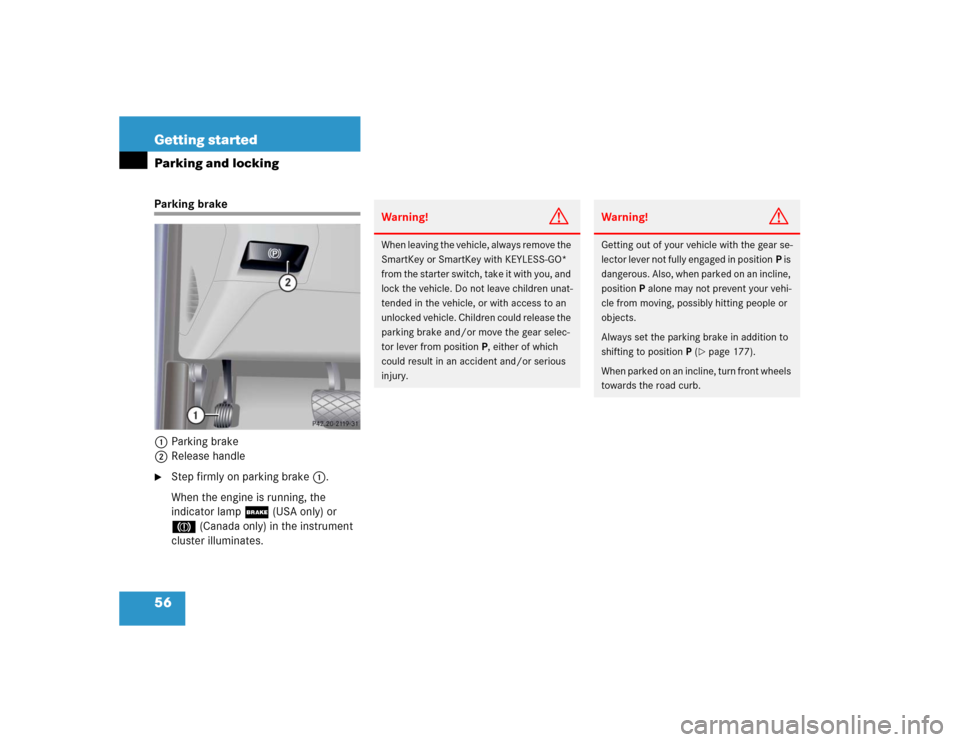Page 38 of 474

36 Getting startedUnlockingPosition 0
Before you press the KEYLESS-GO
start/stop button1, the vehicle’s
on-board electronics have status 0 (as with
SmartKey removed).
Position 1�
Press KEYLESS-GO start/stop
button1 once.
This supplies power to some electrical
consumers, such as seat adjustment.Ignition (or position 2)
�
Press KEYLESS-GO start/stop
button1 twice.
All lamps (except high beam headlamp
indicator lamp and turn signal indicator
lamps unless activated) in the instru-
ment cluster come on. If a lamp in the
instrument cluster fails to come on
when the ignition is switched on, have
it checked and replaced if necessary. If
a lamp in the instrument cluster re-
mains on after starting the engine or
comes on while driving, refer to “Lamps
in instrument cluster” (
�page 338).
For information on starting the engine us-
ing the KEYLESS-GO start/stop button,
see “Starting with KEYLESS-GO*”
(
�page 47).
iIf you now press the KEYLESS-GO
start/stop button �
once again, the ignition (position2)
is switched on
�
twice, the power supply is again
switched off
iIf you now press the KEYLESS-GO
start/stop button once, the power sup-
ply is again switched off.iWhen you switch on the ignition, the in-
dicator and warning lamps (except high
beam headlamp indicator lamp and
turn signal indicator lamps unless acti-
vated) in the instrument cluster come
on. This indicates that the respective
systems are operational. The indicator
and warning lamps (except high beam
headlamp indicator lamp and turn sig-
nal indicator lamps unless activated)
should go out when the engine is run-
ning.
Page 42 of 474

40 Getting startedAdjustingSteering wheel Steering wheel adjustment
The stalk for steering wheel adjustment is
located on the steering column (lower left).
1Adjusting steering column, in or out
2Adjusting steering column, up or down
�
Switch on ignition (
�page 34).
or
�
Open the driver’s door.Adjusting steering column in or out
�
Move stalk forward or back in the direc-
tion of arrow1 until a comfortable
steering wheel position is reached with
your arms slightly bent at the elbow.
Adjusting steering column up or down
�
Move the stalk up or down in the direc-
tion of arrow2.
Make sure your legs can move freely
and all the displays (incl. malfunction
and indicator lamps) on the instrument
cluster are clearly visible.
For more information, see “Heated steer-
ing wheel*” (
�page 253).
Warning!
G
Do not adjust the steering wheel while driv-
ing. Adjusting the steering wheel while driv-
ing could cause the driver to lose control of
the vehicle.
When leaving the vehicle, always remove the
SmartKey or SmartKey with KEYLESS-GO*
from the starter switch, take it with you, and
lock the vehicle.
Even with the SmartKey or SmartKey with
KEYLESS-GO* removed from the starter
switch or the SmartKey with KEYLESS-GO*
removed from the vehicle, the steering
wheel adjustment feature can be operated
when the driver’s door is open. Therefore,
do not leave children unattended in the ve-
hicle, or with access to an unlocked vehicle.
Unsupervised use of vehicle equipment may
cause an accident and/or serious personal
injury.
iThe memory function (
�page 128) lets
you store settings for the steering
wheel together with the settings for the
exterior rear view mirrors and the seat
position.
Page 50 of 474

48 Getting startedDrivingParking brake
1Parking brake pedal
2Parking brake release handle
�
Release the parking brake by pulling
handle2.
The indicator lamp ; (USA only) or
3 (Canada only) in the instrument
cluster goes out.Driving
�
Depress the brake pedal.
�
Move gear selector lever to positionD
orR.
Warning!
G
When leaving the vehicle, always remove the
SmartKey or SmartKey with KEYLESS-GO*
from the starter switch, take it with you, and
lock the vehicle. Do not leave children unat-
tended in the vehicle, or with access to an
unlocked vehicle. Children could release the
parking brake, which could result in an acci-
dent and/or serious injury.
Warning!
G
It is dangerous to shift the gear selector le-
ver out ofP orN if the engine speed is high-
er than idle speed. If your foot is not firmly
on the brake pedal, the vehicle could accel-
erate quickly forward or in reverse. You
could lose control of the vehicle and hit
someone or something. Only shift into gear
when the engine is idling normally and when
your right foot is firmly on the brake pedal.
Page 58 of 474

56 Getting startedParking and lockingParking brake
1Parking brake
2Release handle�
Step firmly on parking brake1.
When the engine is running, the
indicator lamp ; (USA only) or
3 (Canada only) in the instrument
cluster illuminates.
Warning!
G
When leaving the vehicle, always remove the
SmartKey or SmartKey with KEYLESS-GO*
from the starter switch, take it with you, and
lock the vehicle. Do not leave children unat-
tended in the vehicle, or with access to an
unlocked vehicle. Children could release the
parking brake and/or move the gear selec-
tor lever from positionP, either of which
could result in an accident and/or serious
injury.
Warning!
G
Getting out of your vehicle with the gear se-
lector lever not fully engaged in positionP is
dangerous. Also, when parked on an incline,
positionP alone may not prevent your vehi-
cle from moving, possibly hitting people or
objects.
Always set the parking brake in addition to
shifting to positionP (
�page 177).
When parked on an incline, turn front wheels
towards the road curb.
Page 62 of 474

60 Safety and SecurityOccupant safetyIn this section you will learn the most im-
portant facts about the restraint systems
of the vehicle.
The restraint systems are:�
Seat belts
�
Emergency tensioning device
�
Air bags
�
Child seats
�
Child seat recognition
�
Lower anchors and tethers for children
(LATCH)
�
Preventive occupant safety (PRE-SAFE)
As independent systems, their protective
effects work in conjunction with each oth-
er.The 1 indicator lamp in the instrument
cluster comes on
�
for about four seconds when you turn
the SmartKey in the starter switch to
position1 or press the KEYLESS-GO*
start/stop button (
�page 35) once. It
then goes out briefly, comes on again
and remains lit until you start the en-
gine.
�
for about four seconds when you start
the engine by turning the SmartKey or
pressing the KEYLESS-GO* start/stop
button.The restraint systems are fully operational
if the 1 indicator lamp is not lit when
the engine is running.
A malfunction in the system has been de-
tected if the1 indicator lamp:
�
fails to extinguish after approximately
four seconds.
�
does not come on at all.
�
comes on after the engine was started
or while driving.
For safety reasons, we strongly recom-
mend that you visit an authorized
Mercedes-Benz Center immediately to
have the system checked.
For more information, see “Practical hints”
(e page 337).
iFor information on infants and children
traveling with you in the vehicle and re-
straint systems for infants and chil-
dren, see “Children in the vehicle”
(�page 71).
iThe 1 indicator lamp remains lit if
the SmartKey is turned to position 2
and left there or the KEYLESS-GO*
start/stop button is pressed twice. The
indicator lamp will go out when you
start the engine.
Page 83 of 474

81 Safety and Security
Driving safety systems
The - indicator lamp in the instrument
cluster (
�page 24) comes on when you
switch on the ignition (
�page 34). It goes
out when the engine is running.
Braking
At the instant one of the wheels is about to
lock up, a slight pulsation can be felt in the
brake pedal, indicating that the ABS is in
the regulating mode.
�
Keep firm and steady pressure on the
brake pedal while experiencing the pul-
sation.
Continuous, steady brake pedal pressure
yields the advantages provided by the ABS,
namely braking power and the ability to
steer the vehicle.
The pulsating brake pedal can be an indica-
tion of hazardous road conditions and
functions as a reminder to take extra care
while driving.Emergency brake maneuver
�
Keep continuous full pressure on the
brake pedal.
For more information, see “Practical hints”
(
�page 337).
BAS
The Brake Assist System (BAS) operates in
emergency situations. If you apply the
brakes very quickly, the BAS automatically
provides full brake boost, thereby poten-
tially reducing the braking distance.�
Apply continuous full braking pressure
until the emergency braking situation is
over.
The ABS will prevent the wheels from
locking.
When you release the brake pedal, the
brakes function again as normal. The BAS
is then deactivated.
Warning!
G
The ABS cannot prevent the natural laws of
physics from acting on the vehicle, nor can
it increase braking or steering efficiency be-
yond that afforded by the condition of the
vehicle brakes and tires or the traction af-
forded. The ABS cannot prevent accidents,
including those resulting from excessive
speed in turns, following another vehicle too
closely, or hydroplaning. Only a safe, atten-
tive, and skillful driver can prevent acci-
dents. The capabilities of an ABS equipped
vehicle must never be exploited in a reck-
less or dangerous manner which could jeop-
ardize the user’s safety or the safety of
others.
Warning!
G
If the BAS is malfunctioning, the brake sys-
tem is still functioning normally, but without
the additional brake boost available that
BAS would normally provide in an emergen-
cy braking maneuver. Therefore, the braking
distance may increase.
Page 93 of 474
91 Controls in detail
Locking and unlocking
Seats
Memory function
Lighting
Instrument cluster
Control system
Automatic transmission
Good visibility
Automatic climate control
Power windows
Power tilt/sliding sunroof
Driving systems
Loading
Useful features
Page 137 of 474
135 Controls in detail
Lighting
Combination switch
The combination switch is located on the
left side of the steering column.
1High beam
2High beam flasherSwitching on high beams
�
Turn exterior lamp switch to
positionB or toU
(�page 131).
�
Push the combination switch in
direction1.
The high beam indicatorA on the
instrument cluster comes on
(�page 24).High beam flasher
�
Pull the combination switch briefly in
direction2.